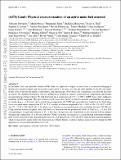(6478) Gault: physical characterization of an active main-belt asteroid
Author(s)
Devogèle, Maxime; Ferrais, Marin; Jehin, Emmanuel; Moskovitz, Nicholas; Skiff, Brian A; Levine, Stephen E; Gustafsson, Annika; Farnocchia, Davide; Micheli, Marco; Snodgrass, Colin; Borisov, Galin; Manfroid, Jean; Moulane, Youssef; Benkhaldoun, Zouhair; Burdanov, Artem; Pozuelos, Francisco J; Gillon, Michael; Green, Simon F; Bendjoya, Philippe; Rivet, Jean-Pierre; Abe, Luy; Vernet, David; Chandler, Colin Orion; Trujillo, Chadwick A; De Wit, Julien; ... Show more Show less
DownloadAccepted version (2.626Mb)
Open Access Policy
Open Access Policy
Creative Commons Attribution-Noncommercial-Share Alike
Terms of use
Metadata
Show full item recordAbstract
<jats:title>ABSTRACT</jats:title>
<jats:p>In 2018 December, the main-belt asteroid (6478) Gault was reported to display activity. Gault is an asteroid belonging to the Phocaea dynamical family and was not previously known to be active, nor was any other member of the Phocaea family. In this work, we present the results of photometric and spectroscopic observations that commenced soon after the discovery of activity. We obtained observations over two apparitions to monitor its activity, rotation period, composition, and possible non-gravitational orbital evolution. We find that Gault has a rotation period of P = 2.4929 ± 0.0003 h with a light-curve amplitude of 0.06 magnitude. This short rotation period close to the spin barrier limit is consistent with Gault having a density no smaller than ρ = 1.85 g cm−3 and its activity being triggered by the YORP (Yarkovsky–O’Keefe–Radzievskii–Paddack) spin-up mechanism. Analysis of the Gault phase curve over phase angles ranging from 0.4° to 23.6° provides an absolute magnitude of H = 14.81 ± 0.04, G1 = 0.25 ± 0.07, and G2 = 0.38 ± 0.04. Model fits to the phase curve find the surface regolith grain size constrained between 100 and 500 $\rm {\mu }$m. Using relations between the phase curve and albedo, we determine that the geometrical albedo of Gault is pv = 0.26 ± 0.05 corresponding to an equivalent diameter of $D = 2.8^{+0.4}_{-0.2}$ km. Our spectroscopic observations are all consistent with an ordinary chondrite-like composition (S, or Q-type in the Bus-DeMeo taxonomic classification). A search through archival photographic plate surveys found previously unidentified detections of Gault dating back to 1957 and 1958. Only the latter had been digitized, which we measured to nearly double the observation arc of Gault. Finally, we did not find any signal of activity during the 2020 apparition or non-gravitational effects on its orbit.</jats:p>
Date issued
2021Department
Massachusetts Institute of Technology. Department of Earth, Atmospheric, and Planetary SciencesJournal
Monthly Notices of the Royal Astronomical Society
Publisher
Oxford University Press (OUP)